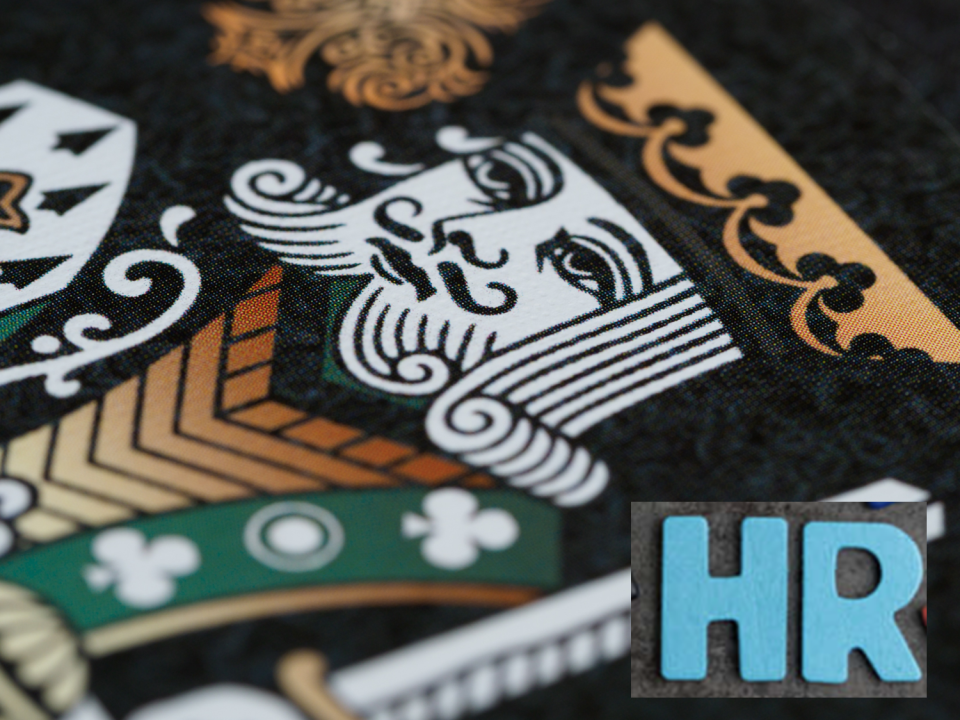Is, HR more Loyal to the Business, than Business itself ?

Is, HR more Loyal to the Business, than Business itself ?
The phrase “more loyal to the king than the king himself” refers to a level of devotion or fidelity that exceeds that of the monarch or ruler they serve. It suggests that the person in question is even more dedicated to the interests and well-being of their sovereign than the ruler is themselves.
One example of corporate loyalty that could be described as “more loyal to the company than the company itself” is Steve Jobs’ dedication to Apple. Jobs co-founded Apple in 1976, and after being ousted from the company in 1985, he returned in 1997 to help save the struggling tech giant. Jobs was known for his fierce commitment to Apple’s vision and products, often prioritizing them over profits or shareholder concerns. In one famous example, he famously refused to allow Adobe Flash on Apple’s mobile devices, despite the popularity of the technology, because he believed it was not the best choice for Apple’s users.
One example of a corporate HR leader whose loyalty to the company may have backfired is Travis Kalanick, the co-founder and former CEO of ride-hailing company Uber.
Kalanick was known for his extreme loyalty to Uber and his determination to achieve the company’s aggressive growth targets. However, this loyalty sometimes came at the expense of the company’s employees, customers, and other stakeholders.
Under Kalanick’s leadership, Uber was criticized for a number of unethical practices, such as aggressive expansion into new markets without regard for local regulations or cultural norms, a toxic workplace culture that included allegations of sexual harassment and discrimination, and controversial business practices such as “greyballing” to evade authorities.
Despite these issues, Kalanick remained committed to Uber’s vision and growth targets, and was reluctant to make significant changes to address the company’s problems. This eventually led to his resignation as CEO in 2017, following a series of scandals and a loss of confidence from investors and the public.
Kalanick’s extreme loyalty to Uber and its goals ultimately may have contributed to the company’s problems, as it led to a disregard for other important obligations and stakeholders. This case illustrates the importance of balancing loyalty to a company with ethical and responsible decision-making.
HR ROLE
While Human Resources Management function was first envisaged, it was primarily meant to take care of the welfare of employees in an organisation.
DAVE ULRICH HR MODEL
However the modern HR guru, Dave Ulrich, came up with The Ulrich model of HR. It is a model that helps to organize roles and responsibilities across HR departments. This HR model was first introduced by David Ulrich in 1995 as a way of organizing HR functions.
- Strategic Business Partner
- Change Agent
- Employee Champion
- Expert Administrator
When Dave Ulrich exhorted that HR needs to become trusted Strategic Business Partners, it looks like HR took it too seriously and forgot that he also defined 3 other Roles that HR needs to don the hat. A lot of progress has been made with regards to Change Management and Adminstrative Expert. But over the decades has HR forgot its role as Employee Champion?
HR is often seen as prioritizing the interests of the company and senior management over those of the employees, particularly in times of economic hardship.
The U Turn by companies post COVID19
Just after the COVID pandemic HR went over board in hiring and stepped up the ante in the job market. Employees bargaining 70% and even 100% pay increases were no surprises. Within a span of one year, companies turned the tide and resorted to mass layoffs.
MASS LAYOFFS
Look at the sheer layoff By Major Tech Firms in 2023: Company-wise Details
- Microsoft Layoffs — 10,000 employees (5% of workforce)
- Amazon Layoffs — 8,000 (3% of workforce)
- Salesforce Layoffs — 8,000 (10% of workforce)
- Dell Layoffs — 6,650 (5% of workforce)
- IBM Layoffs — 3,900 (2% of workforce)
- SAP Layoffs — 3,000 (3% of workforce)
- Zoom Layoffs — 1,300 (15% of workforce)
- Coinbase Layoffs — 950 (20% of workforce)
- Yahoo Layoffs — 1,600 (20% of workforce)
- GitHub Layoffs — 300 (10% of workforce).
HR’s credibility
No doubt the credibility of HR has taken a beating further adding fuel to the fire “HR is Dead”.
HR is seen as being complicit in decisions to lay off employees, rather than advocating for alternative solutions such as reduced hours or furloughs. HR often fails to address broader issues of inequality and inequity within the workplace that can contribute to mass layoffs in the first place. For example, HR may fail to advocate for fair pay, benefits, and job security for all employees, instead prioritizing the interests of senior management or certain departments. This can exacerbate existing inequalities and ultimately contribute to mass layoffs when the company faces economic difficulties.
In one of the companies that I worked when faced with a dire economic downturn, the leadership team at the Company led by CEO and myself (CHRO) took a conscious decision of paycuts for Managers and above and not resorting to layoffs.
Most of us know that Layoff is not the solution for long term health of the company. Its just a stop gap knee jerk reaction. But we still fall prey to its temptation.
LAYOFF STRATEGY – DOES IT REALLY WORK ?
The research on the effects of mass layoffs on business results and employee morale is mixed. While some studies suggest that layoffs can lead to improved financial performance, others find that they have negative effects on employee morale and job performance.
- One study conducted by McKinsey & Company analyzed the performance of over 1,000 companies during the 2008 financial crisis and found that companies that implemented layoffs early in the crisis were more likely to recover quickly and perform better in the long term. However, the study also found that companies that focused on retaining and engaging their employees during the crisis were more likely to outperform their peers in the years following the crisis (McKinsey & Company, 2009).
- On the other hand, a study by the University of Warwick found that layoffs can have negative effects on the productivity and morale of the remaining employees. The study analyzed data from over 2,500 British workplaces and found that layoffs led to a decline in productivity among the remaining workers, as well as increased stress and decreased job satisfaction (Bryson et al., 2013).
- Another study by the Society for Human Resource Management found that layoffs can have negative effects on employee morale and engagement, which can in turn impact business results. The study surveyed over 600 HR professionals and found that companies that prioritized employee communication and support during layoffs were more likely to maintain employee engagement and minimize the negative effects on business results (Society for Human Resource Management, 2010).
Overall, the research suggests that while mass layoffs can lead to improved business results in the short term, they can also have negative effects on employee morale and job performance. Companies that prioritize employee communication and support during layoffs, and focus on retaining and engaging their employees during times of crisis, may be more likely to outperform their peers in the long term.
CIRCLE OF SAFETY
The modern day management guru, Simon Sinek often uses the idea of a “circle of safety” to describe the importance of building a sense of trust and community within an organization. He suggests that this circle of safety is similar to the sense of belonging and protection that we experience in our families or in the military.
In a family, we often feel a strong sense of belonging and loyalty to our loved ones, and we are willing to support and protect them even in difficult times. Similarly, in the military, soldiers often feel a deep sense of camaraderie and loyalty to their fellow soldiers and commanders, and they are willing to risk their lives to protect the group.
In an organizational context, Sinek suggests that leaders can build a similar sense of belonging and loyalty by creating a culture of trust, support, and shared values. When employees feel that they are part of a strong, supportive community, they are more likely to feel motivated and committed to their work, even in challenging times.
Who else is better equipped to provide this Circle of Safety, than HR in an organization.
HR NO MORE SEEN AS EMPLOYEE CHAMPION
HR is no more seen as the Employee Champion. There are several reasons why HR has failed to be the employee champion:
- Limited Influence: In many organizations, HR has limited influence and decision-making power. This can make it difficult for HR to implement policies and initiatives that truly benefit employees.
- Lack of Empathy: One of the most important roles of HR is to be a voice for employees and advocate for their needs. However, many HR professionals lack empathy and fail to truly understand the needs and concerns of employees.
- Lack of Strategic Focus: HR has often been seen as a support function, rather than a strategic partner to the business. This has led to HR being overlooked in decision-making and not being involved in strategic planning.
- Ineffective Communication: HR often fails to communicate effectively with employees, leading to misunderstandings and mistrust. This can lead to a lack of engagement and a negative perception of HR.
- Lack of Accountability: HR is often not held accountable for employee satisfaction and engagement, which can lead to a lack of ownership and responsibility for employee issues.
- Focus on Compliance: HR has traditionally focused on compliance and legal issues, rather than employee needs and satisfaction. While compliance is important, it should not be the sole focus of HR.
WHERE DO EMPLOYEES TURN TO – UNIONS
No wonder we are seeing the rise of White Collar Employee Unions and Tech Workers Unions. Look at the proliferation of the unions:
- The Communications Workers of America (CWA) has organized tech workers at companies such as Google, Facebook, and Microsoft. The CWA has advocated for better working conditions, job security, and ethical practices within the tech industry.
- The Tech Workers Coalition (TWC) is a grassroots organization that advocates for tech workers’ rights and social justice issues. The TWC has organized protests and walkouts at companies such as Google and Amazon, and has pushed for greater accountability and transparency in the tech industry.
- The New York Tech Workers Coalition (NYTWC) is a local organization that focuses on issues affecting tech workers in New York City. The NYTWC has advocated for better pay and working conditions, as well as for greater diversity and inclusion in the tech industry.
- The Campaign to Organize Digital Employees (CODE-CWA) is a project of the CWA that aims to unionize tech workers across the United States. CODE-CWA has organized workers at companies such as Glitch and Kickstarter, and has pushed for greater worker power and representation in the tech industry.
- The Forum for IT Employees (FITE) is a trade union that represents IT and ITES (IT-enabled services) workers in India. FITE has organized protests and strikes over issues such as layoffs, wage cuts, and poor working conditions, and has also advocated for better job security and protection of workers’ rights.
- The National Information Technology Employees Senate (NITES) is another trade union that represents IT and ITES workers in India. NITES has focused on issues such as job security, wage hikes, and reduction of working hours, and has also provided legal aid and support to workers who have faced discrimination or harassment at work.
- The Indian IT Workers’ Association (ITWA) is a trade union that represents IT workers in Kerala, a southern state in India. ITWA has organized protests and strikes over issues such as layoffs and salary cuts, and has also advocated for better working conditions and protection of workers’ rights.
- The Karnataka State IT/ITeS Employees Union (KITU) is a union that represents IT and ITeS workers in the state of Karnataka, which is a major hub for the IT industry in India. KITU has focused on issues such as job security, wage hikes, and improvement of working conditions, and has also provided legal aid and support to workers who have faced discrimination or harassment at work.
These are just a few examples of the growing movement of White Collar workers’ unions and organizations, which are striving to represent Employee’s voice in organisations and trying to promote greater accountability and responsibility within the industry.
When HR fails to empathise with its employees, provide a Circle of Safety to its employees and abdicates its responsibility of being the Voice of its Employees and does not become an Employee Champion, employees will resort to third parties to voice their grievances and fight for their rights.
Its also time to bring back the Humane in HR.
So has HR aligned itself more with shortsighted Business interests than long term Employee interests. Has HR abdicated its responsibilities of being an Employee Champion. Has it become more loyal to the Business, than Business itself.
Dave Ulrich and Simon Sinek your views on this plz……
————————————————————————————
Sources:
- McKinsey & Company. (2009). From cost to resilience: How companies can prepare for the next downturn. https://www.mckinsey.com/business-functions/organization/our-insights/from-cost-to-resilience-how-companies-can-prepare-for-the-next-downturn
- Bryson, A., Forth, J., & Stokes, L. (2013). Does mass layoff participation damage future employability? https://warwick.ac.uk/fac/soc/economics/research/workingpapers/2013/twerp_1006_bryson_forth_stokes.pdf
- Society for Human Resource Management. (2010). The impact of downsizing on employee engagement. https://www.shrm.org/hr-today/trends-and-forecasting/special-reports-and-expert-views/Documents/SHRM%20Research%20Report_Downsizing.pdf






Responses